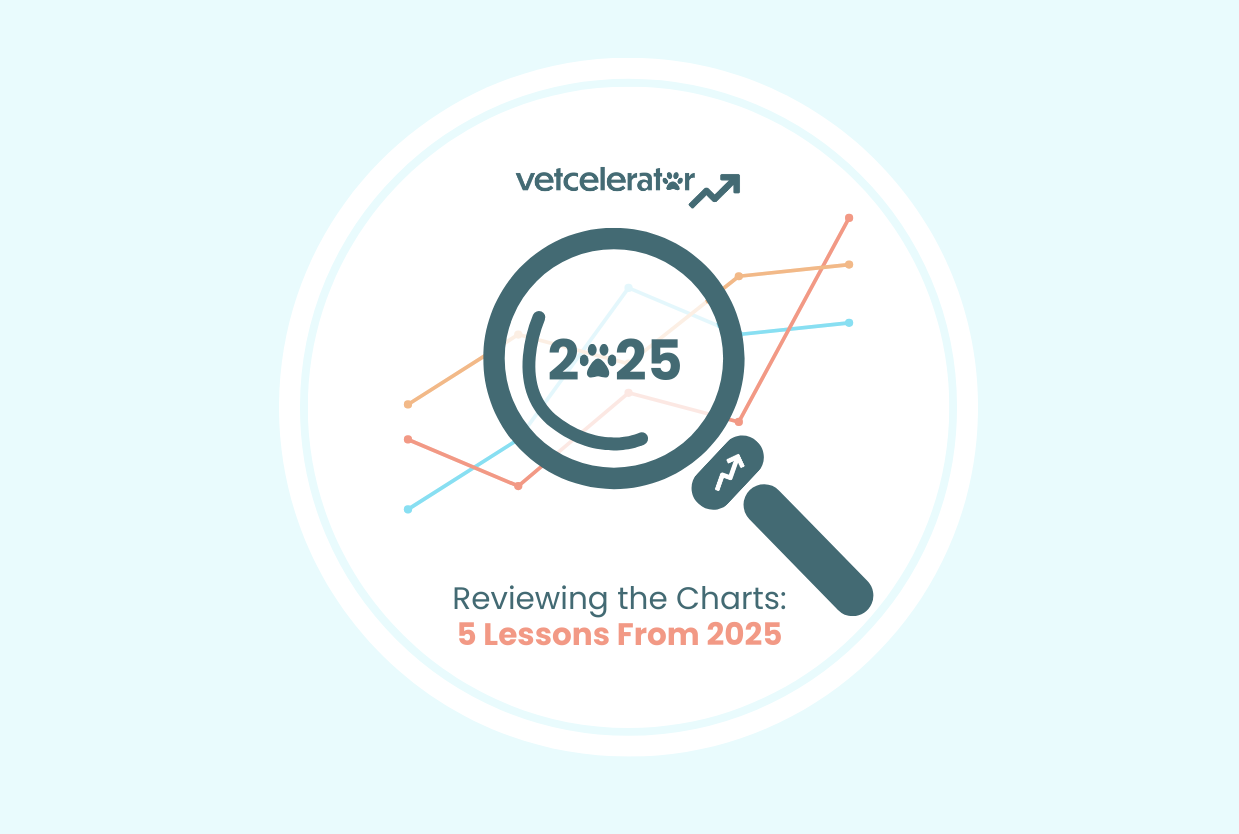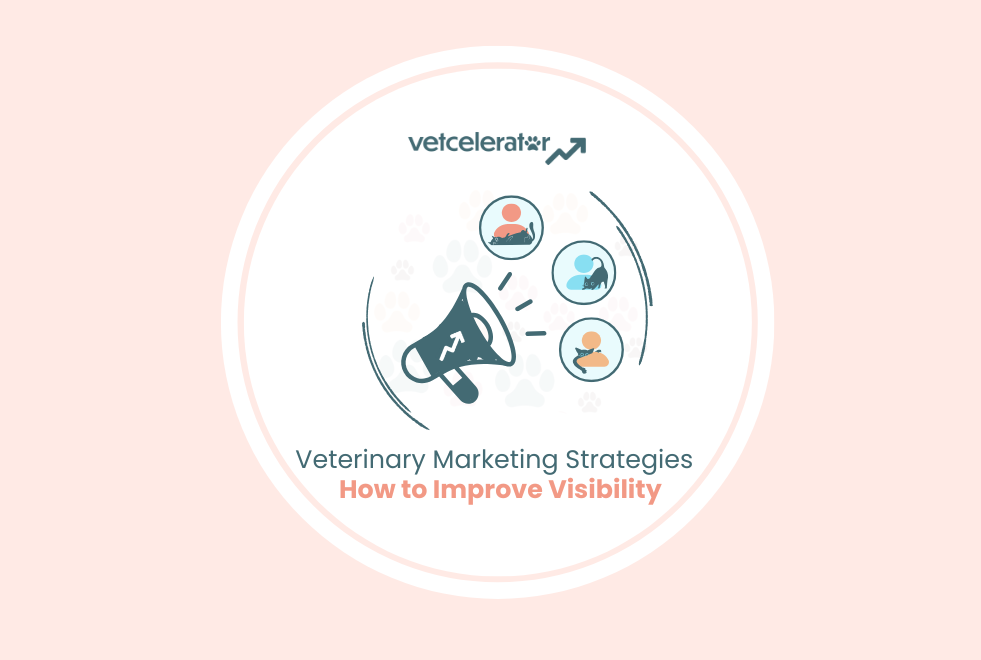At Vetcelerator, we believe every business problem is a marketing problem. Our mission is founded on the premise that effective marketing, informed by data and strategy, can address operational, financial, and growth challenges across veterinary practices.
That’s why we deploy marketing professionals who understand the veterinary industry, not just in theory, but in the metrics that matter and the platforms that perform.
This blog series breaks down the core components of digital advertising for veterinary clinics. From defining goals to understanding ad platforms and interpreting data, our objective is to equip you with the clarity to make informed marketing decisions.
Here’s what’s ahead:
-
- Measurement That Matters: Tracking Conversions in Veterinary Marketing
- How First-Party Data Enhances Audience Insights for Veterinary Clinics
- Ad Campaign Types Explained: Choosing the Right Strategy for Your Veterinary Clini
- When to Use High-Intent vs Awareness Campaigns in Veterinary Marketing
- Veterinary Clinics: How to Balance Awareness and High-Intent Ads
- Impression Share: What It Is and Why It Matters for Veterinary Clinics
- 5 Signs It’s Time to Increase Your Veterinary Marketing Budget
- Measurement in Action: Using Marketing Data to Guide Veterinary Growth
- First-party data has been in veterinary internet marketing headlines for a couple of years, and today, we are going to break that down and detail what it means to you and your marketing efforts.
Note from the Author
I remember the first Search Marketing Advanced (SMX) conference I attended years ago. One of the speakers’ first slides was simple. It said, “Your job is hard.”
I want to start this piece by acknowledging that digital marketing for vets is constantly evolving and making it quite “hard”. The toolkits we mastered five years ago will not be as effective today, as the way pet owners search and absorb content has rapidly changed. With the introduction of AI less than two years ago, it will continue to evolve at a rapid rate.
The theme of this blog is first-party data, but before we dive into that topic, we should take a look at what’s changing with third-party data and what that means for veterinary marketing.
Third-Party Data and the Veterinary Industry
As technology continues to evolve, so do the tools and regulations that are put in place to protect the users and their information. “Third-party data” is a term that most business owners and marketers should be familiar with. This is typically behavioral and transactional data that is collected about a user over the internet.
Common third-party data collectors are:
Internet Browsers (Chrome, Safari, Firefox)
- Browsers track user behavior across websites through cookies and analytics scripts. Data from browsers is used to understand session duration, bounce rates, and referral sources, powering tools like Google Analytics.
Social Media Channels (Facebook, Instagram, LinkedIn)
- Provide real-time engagement and demographic data that inform how content is received and shared, enabling audience targeting and refined content.
Ad Networks (Google, Meta, Microsoft, Amazon)
- These third-party ad networks provide valuable campaign performance data such as impressions, clicks, and conversions. They’re essential for evaluating and optimizing veterinary advertising Return on Spend (ROAS).
An easy way to think about third-party data is that it’s information collected about you based on your online habits. What you search for, what you click, and how long you view a page, and most of that data comes from something called cookies.
So, what is a cookie?
Unfortunately, these aren’t your grandma’s homemade cookies. These are the little pop-ups we all speed-click through, giving websites permission to track what we’re doing.
Cookies are sweet, just not in the buttery-sugar kind of way. They’re sweet because they quietly collect behavior data that helps marketers understand trends.
4 facts about Cookies
2. Cookies understand how people use your site.
Cookies show marketers which pages pet owners visit, how long they stay, and where they drop off. That insight can be used by a veterinary marketing team to adjust what’s not working and lean into what is.
1. Cookies remember repeat visitors.
If someone visits your site, cookies help your website recognize them the next time. It’s like a digital “welcome back.” Forms are pre-filled, pages load faster, and it feels a little more personal.
3. Cookies remind the right people to come back.
If someone visits your site but doesn’t book, cookies know to show them your ad again on Facebook, Google, or wherever they are. That little nudge is called remarketing, and it works.
4. Cookies make spending smarter.
Cookies have the data to tell us if you visit vetcelerator.com and view all our Recruiting pages. If you don’t reach out to our recruiting team, we can show you remarketing ads with recruiting content vs showing you ads on our marketing solutions. Highly relevant ads mean a better return on spend, aka less waste for more results. Win, win.
The Cookie Will Crumble: The Meaningfor Veterinary Internet Marketing

Third-party data is slowly being phased out. This shift is driven by growing concerns around privacy. This is a good thing. People want more control over their data, and regulators are enforcing it.
Browsers like Safari and Firefox already block most third-party cookies. Google Chrome, the most widely used browser, is phasing them out entirely.
So we were just starting to like cookies, and now they’re going away?
Yes, slowly but surely, third-party cookies are being phased out, challenging marketers to rethink how they reach the right people at the right time.
Without third-party cookies, tracking user behavior across websites becomes significantly more challenging. You’ll no longer be able to follow a potential client from a blog they read to your website and then retarget them with an ad on Facebook. That rich behavioral veterinary marketing data is drying up.
First-Party Data in Digital Marketing for Vets
As third-party data steps out, first-party data steps into the spotlight of digital marketing for vets. First-party data is information you collect directly from your clients or prospects. It’s the most reliable and permission-based data available, as it comes directly from the source.
Types of First-Party Data for a Veterinary Clinic
Website Appointment Forms
Contacts from PIMS or
Booking System
Phone Calls & Transcripts
Website Appointment Forms
Contacts from PIMS or
Booking System
Phone Calls & Transcripts
Level Up with First-Party Data & Machine Learning
When you integrate first-party data into your ad platforms like Google Ads and Meta, you’re giving the algorithm a much clearer picture of who your ideal clients are, leading to audience targeting. It’s like handing over a digital fingerprint of the kind of pet owners you want more of. These data sets (a list of emails, phone numbers, or site behaviors) can be uploaded manually or fed into your campaigns through a spreadsheet or a direct integration. Once it’s there, the system knows exactly who to look for and when.
Best Practices for First-Party Data to Gather
List must be 1000 contacts
First and last names
Phone numbers
Zip code
Country code
List must be 1000 contacts
First and last names
Phone numbers
Zip code
Country code
Savvy Segmenting
To outperform the competition, start segmenting your audience based on where they are in the client journey. This approach gives the algorithm clearer signals, making it easier to identify who’s most likely to convert and when to reach them.
Think of it like this:
Marketing Lead → High-Quality Lead → Customer → High-Quality Customer → Repeat Customer
That’s the path to smart marketing for veterinarians. And when you feed that journey into the machine, you’re training the platform to work smarter for you. The technology is improving daily, but how well you organize and feed it matters.
For thinking about segmentation overall, check out our blog on Mastering Market Segmentation.
Savvy Spending
Acquiring a new customer is typically 5 to 7 times more expensive than retaining an existing one. With first-party data, you can send laser-focused ads to pet owners who haven’t visited in over a year.
Think: “Book in the next 14 days and get a free dental cleaning.” That’s how you get the right people back in the door without blasting everyone and lowering return on spend.
You can also avoid wasting your ad budget by filtering out current clients, as there’s no sense in advertising to someone who just came in last week. First-party data lets you spend smarter and make every marketing dollar work harder.
Next-Gen PMAX Campaigns

We talked about first-party data and how it will help the system identify who your ideal customers are for veterinary internet marketing. One of those systems is PMax campaigns, also called Performance Max. These campaigns are not about customers’ search words but what the customer is searching. Signals are what they are called, but a more appropriate term would be themes. Whether you are searching for dog food, new pets, pet supplies, or even pet insurance, PMax campaigns look at what people are searching for and target like-minded individuals with ads that could benefit them.
With the integration of first-party data and combining that with how PMax campaigns work, you get a powerhouse ad that knows who your clients are and their search patterns, and the ad will find other ideal individuals that match your current clientele. Digital marketing for vets then hits its full stride.
Conclusion
As third-party data and cookies fade out and AI-driven targeting takes center stage, your veterinary clinic’s ability to collect and use first-party data is a strategic advantage. The earlier you capture this data in the client journey, the more effectively you can use it to shape campaigns, reduce ad spend, and drive higher-value bookings.
At Vetcelerator, we’ve seen firsthand how clinics using first-party veterinary marketing data outperform those that don’t. From higher engagement rates to more efficient ad performance, the difference is clear.
Curious how first-party data can drive smarter marketing for your veterinary clinic? Let’s talk. We’ll show you what’s working, what’s changing, and how to stay ahead.




